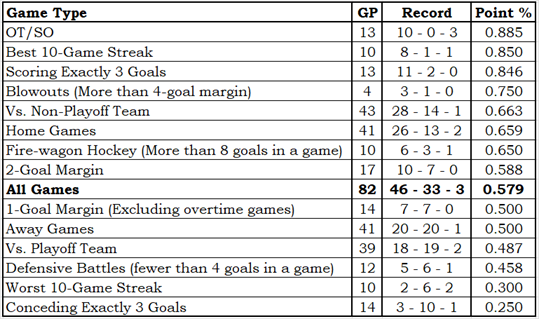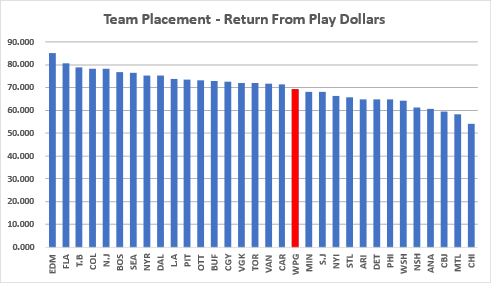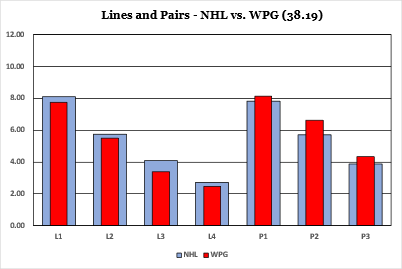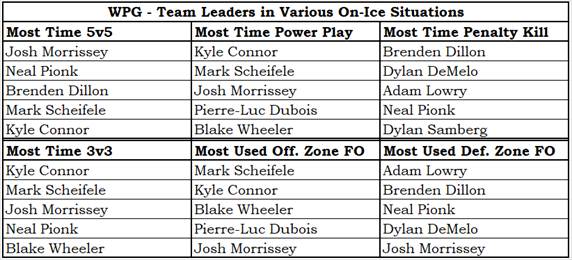Standings

Team Record by Game Type

More information regarding Team Record by Game Type
The Team Record by Game Type is based on an idea I saw in a Bill James Baseball Abstract (exact year unknown; it was in an Abstract from the 1980s). It showed how a specific team did in various types of games, and it is exactly the sort of thing that I really like.
The table is sorted by point percentage (Point % column), so each team’s content order will be different and logically related game types could be well separated. Since that is the way that Bill James did it, it must be the correct way.
OT/SO is a team’s record in overtime and shootout games. These games are impossible to lose, so the loss count will always be zero. A loss is a game in which a team gets no standing points; a tie is a game in which a team gets one standing point, as they do in overtime or shootout losses.
Conceding Exactly 3 Goals and Scoring Exactly 3 Goals show how teams did in games where they scored enough to have a chance to win or conceded just enough that they could win.
1-Goal Margin, 2-Goal Margin and Blowouts (More than 4-goal margin) are for games with scores like 6-5, 6-4 and 6-1 (respectively). The 1-goal games do not include OT/SO games.
Defensive Battles and Fire-wagon Hockey are for games with scores like 2-0 and 7-3 (respectively). The entire set of Defensive Battle scores are 3-0, 2-1, 2-0 and 1-0.
Vs. Playoff Team and Vs. Non-Playoff Team are based on opponent playoff status at the end of the season, not at the time of the game. Two examples: Pittsburgh would be a non-playoff opponent and Florida would be a playoff opponent.
Best 10-Game Streak and Worst 10-Game Streak need no further explanation.
Home Games, Away Games and All Games need no further explanation.
Hide additional Information regarding Team Record by Game Type
Talent Distribution

More information regarding Talent Distribution
The Talent Distribution tables show how player talent is distributed in a team.
The Count by Category table shows how many players the team has in each of the six PR Categories, broken down by position. It is good to have PR-Elite and PR-Star players.
The PR% by Age Group table shows where the team’s productivity lies by age group. For context, it also shows the league averages.
If a team has a lot of talent in the younger age groups you would think that was a good omen for the team’s future, while if the team has a lot of talent in the older age groups that would seem to be a bad omen: old players don’t get better, they get worse.
The PR% by Draft Status shows how a team acquired the talent they have, by one of three categories: they drafted the player, another team drafted the player, or the player was undrafted. In order to provide a little context, league averages are also shown.
This information is more “how a team got their talent” than “how a team should get its talent.”
It would be nice if the players a team drafts do well and stay with the team, but it is also nice to acquire talent from other teams, and it is also nice to sign an undrafted free agent.
Hide additional Information regarding Talent Distribution
Return From Play Dollars

More information regarding Return From Play Dollars
Return From Play (RFP) translates a player’s Productivity Rating into a dollar amount that is loosely based on the 2021-22 salary cap. It has nothing to do with how much a player was paid: it is about how much a player was worth.
We do this sort of thing all the time. “They charged me $10 for the hamburger, but it tasted like a $30 steak.” “I bought my used car for $10,000, but it rides like a $50,000 car.” “I paid $500 a night for a hotel in Toronto; the place might have been worth $200.”
In 2022-23, Zach Hyman (EDM) was in the PR-Star category and had a PR-Score of 8.6554. His RFP was $7,040,000, based on his PR-Score. Essentially, he played like a $7-million player.
Seasonal RFPs can be added together, producing a total RFP for a player over time. Auston Matthew’s (TOR) return from play in his career is $55,920,000.
The RFP of all players on a team can be added together, telling us something about the level of talent on it. Colorado’s RFP in 2022-23 was $78,340,000, while the RFP of Columbus was $59,455,000. Colorado had the better players.
Hide additional Information regarding Return From Play Dollars
Lines and Pairs

More information regarding Lines & Pairs
The Lines and Pairs section consists of the chart above and the table below. The chart shows where the team’s talents are in comparison to the league average, while the table shows which players are on which forward line or which defensive pair.
Players are sorted by team, by position and by their PR-Score. Traded players will use have their PR-Score apportioned based on how many games they played with each team. A player who played 50 games with one team and 25 games with a second team will be assigned 2/3 of his PR-Score for the team he played 50 games for, and 1/3 of his PR-Score for the team he played 25 games for.
The top three forwards are identified as the first line, the next three as the second line, and so on. There is no guarantee that any line has actually played even one second together during the season: the lines and pairs are solely based on productivity rating.
There are times when a player who was traded at the trade deadline will appear on the L&P table for both teams he played for. That just means that he was one of the top twelve forwards (or top six defensemen) for both teams, based on the statistics he accumulated with each team.
Hide Information regarding Lines & Pairs

Team Leaders – Stapled To The Bench Categories

More information regarding Team Leaders – Stapled To The Bench Categories
The Team Leader table identifies the best player on the team in six Stapled To The Bench categories. I will not go into the formulas used.
- The Most Productive player is the player with the highest PR-Score.
- The Most Valuable player is the player with the highest VR-Score.
- The Best Center is the player who was their team’s most highly rated center.
- The Most Disruptive player is based on blocked shots, hits and take-aways.
- The Best Power Player is based on both individual and team statistics that comes from powerplay time-on-ice.
- The Best Penalty Killer is based on statistics that comes from short-handed time-on-ice.
Hide additional Information regarding Team Leaders – Stapled To The Bench Categories
Team Leaders – On-Ice Situations

More information regarding Team Leaders – On-Ice Situations
- The Team Leaders for various On-Ice situations table shows the players who got the most ice-time in certain situations.
- In the time categories, players are ranked by ice-time (in minutes played) over the season, not on ice-time per game played.
- A player who is normally heavily used in a certain situation but who missed a non-trivial number of games could fall out of the top five for his team.
- The two non-time categories show players ranked by the percent of their shifts that started in offensive or defensive zones.
- While I normally prefer to use actual counts, it seemed correct for these two categories to use percentages, provided they played a minimum number of minutes during the season.
- A minimum-time criteria avoids avoid identifying a player who played one or two games during the season as being one of the most heavily used offensive zone or defensive zone players.
Hide Information regarding Team Leaders – On-Ice Situations
Team Essay – It is What it Is, but it Ain’t What it Was
After 40 games the Jets had a 26-13-1 record. They were on pace for 108 points in the standings, but they finished with 92. There is a level of confusion when you compare Winnipeg’s team-level data for their first 40 games to their last 42 games, so I thought I would wallow around in this confusion.
After the games of January 9th 2023, the Jets and the Devils had remarkably similar records. They were tied in points and practically tied in goals for and goals against.

In their next 42 games, New Jersey played ever so slightly better while the Jets played very much worse, as shown below.

It looks like Winnipeg’s problems were equally divided between offense and defense, as they scored 18 fewer goals and gave up 18 more goals in their last 42 games, but that is slightly deceiving. They played two more games in their “second half”. Looking at the average score per game is a better approach to determining where the problems were.

We now see that the problems in the last 42 games were (math math math) about 66% offense. To delve a little deeper into the problem, I want to compare the goals they actually scored with the goals they were expected to score. There is an official statistic which tells us how many goals should have been scored: expected goals.
Here’s the two-minute primer on “expected goals (xG)”. Every shot on net is associated with an expectation of scoring. A wrist shot from the point has a low possibility of scoring; a snap shot from the slot has a higher possibility of scoring. Ten wrist shots from the point might have a total expected goals of 0.2, while ten shots from the slot might have an expected goals total of 3.0.
To me, expected goals describes how well a team played. Since neither life nor hockey is fair, the results of team play (actual goals) aren’t always the same as the expectations.
Looking at the Winnipeg Jets defense, the last-42-game “problem” is easy to determine. Winnipeg Jets goalies played extremely well in the first 40 games, while they were “only” a little better than average in the last 42 games. In those first 40 games, Winnipeg goalies gave up 22.82 fewer goals than expected, while they gave up 4.77 fewer goals than expected in the second half. Because they didn’t make outstanding saves as frequently, they gave up 18.05 more goals in the second half.
It’s on offense where the data gets a little confusing.
In their first 40 games, the Jets scored 6.62 goals more than expected. They were getting a little puck-luck, getting one goal above expectation every six games. In those last 42 games the puck-luck turned on them with a vengeance: Winnipeg scored 28.04 fewer goals than expected. That’s a change of 34.66 goals, a rate of five goals every six games.
If you look back at the difference between goals for in the first 40 games and the last 42 games you’ll see it was 18, not 34.66. Why are those two figures so different? Because Winnipeg played better offensively in the last 42 games. This is the confusion I was talking about.
In the first 40 games, Winnipeg’s expected goals for per game was 3.13. In the last 42 games, Winnipeg’s expected goals for per game was 3.38. Over 42 games that improvement in offensive play should have netted the Jets an extra 10 or 11 goals. Instead, they scored about 24 goals fewer.
When a team gives up fewer goals than expected, it is easy to place the credit on the goalies. When a team gives up more goals than expected, it is easy to place the blame on the goalies. When a team scores fewer goals than expected, should we blame the forwards or credit the opposing goalies? Logically, when it is a team that isn’t scoring according to expectations, you have to place the blame on their skaters.
I guess what I am saying is that the team lost its scoring touch. It is much easier to believe that several key Jet players lost their touch than that dozens of opposing goalies happened to play very well against the Jets.
The data indicates that the Jets did increase their offensive effort, Looking at the combined data of twelve Jets forwards and defensemen who played a good number of minutes in both halves of their season, their Corsi-For went up 9% and their expected goals for went up 11%. It’s just that their actual goals scored went down 5%.
Their sticks went cold. The puck seemed to weigh more. The ice was choppier. They were clutching their sticks too tightly. I have no idea why they lost their scoring touch, but they did.
